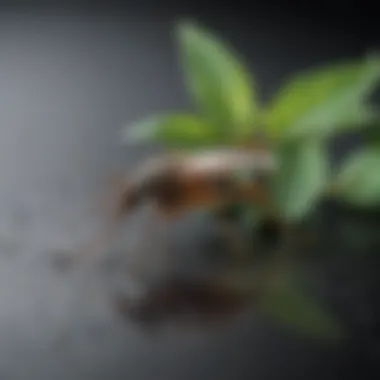Do Mint Repel Mosquitoes? An In-Depth Exploration


Intro
Understanding how to repel mosquitoes using natural methods is crucial for maintaining a comfortable living environment, particularly during warmer months. Among various options, mint is often highlighted as a potential deterrent for these pesky insects. This exploration aims to uncover the properties of mint that make it an effective mosquito repellent, while discussing the nuances in its application and cultivation. Additionally, this article will provide insights into the ecological implications and practical strategies for incorporating mint into pest control efforts.
Understanding Pests
Definition of Pests
Pests are organisms that can negatively impact human health, cause damage to property, or disrupt the natural ecosystem. In the context of this article, mosquitoes are considered pests due to their ability to transmit diseases and cause discomfort through their bites. Understanding their behavior and biology is essential for effective control.
Importance of Pest Identification
Identifying the specific type of pest is fundamental to choosing the right control methods. Different species of mosquitoes, for instance, have varied breeding habits and responses to repellents. Knowing whether you are dealing with Aedes, Culex, or Anopheles mosquitoes, for example, can guide the selection of repellents and other control strategies that may be more effective.
Prevention Techniques
Home and Garden Preventative Measures
Creating an inhospitable environment for mosquitoes is key to effective prevention. Here are some strategies to consider:
- Remove Standing Water: Mosquitoes breed in stagnant water. Empty flower pots, bird baths, and clogged gutters regularly.
- Use Screens: Ensure windows and doors are fitted with fine mesh screens to keep mosquitoes out.
- Plant Mosquito-Repelling Plants: Incorporate mint and other aromatic herbs into your garden. Their scents can deter mosquitoes and beautify your space.
Seasonal Prevention Tips
During warmer months, extra caution is needed. Here are some seasonal tips for preventing mosquito problems:
- Apply Repellent: Use EPA-registered repellents when spending time outdoors.
- Dress Appropriately: Wear long sleeves and pants in outdoor settings, especially around dusk.
- Maintain Yard: Keep the grass and shrubs trimmed to reduce hiding spots for adult mosquitoes.
Eco-Friendly Pest Control Solutions
Overview of Sustainable Practices
Using eco-friendly methods for pest control can benefit both the environment and your health. Mint presents itself as a viable option in this regard, as it requires less harmful chemicals than conventional methods. Integrating sustainable practices makes pest management more effective without risking ecological balance.
Natural Remedies and Their Effectiveness
"Natural remedies like mint are not only safer for the environment but also can be quite effective against pests, including mosquitoes."
Among various natural remedies, mint oil shows promise. Its strong aroma may interfere with the mosquitoes' ability to detect humans, thus reducing bites. Other effective natural repellents include citronella, eucalyptus, and lemongrass. While they might not provide complete protection like synthetic repellents, they are a step towards a more sustainable approach to pest management.
Incorporating these practices requires careful planning, but the payoff can be significant, both in comfort and in health. This exploration continues by examining the scientific evidence supporting mint as a repellent, methods for cultivation, and the challenges associated with its use.
Prelims
The quest to find effective mosquito control methods remains a pressing challenge, especially in regions where these insects thrive. Mosquitoes not only pose an annoyance but also serve as vectors for various diseases. As they continue to adapt and evolve, traditional chemical repellents may not suffice for every situation. This article aims to explore the potential of mint as a natural repellent for mosquitoes, focusing on its chemical composition, various species, and practical applications.
Understanding the significance of mosquito control provides a foundation for why investigating alternatives like mint is essential. With rising concerns about chemical exposure and environmental impacts, a growing number of individuals seek natural solutions. In this light, using plants such as mint may offer not only a way to repel these pests but also enrich the surrounding ecosystem.
The journey through this article will cover key aspects such as the effectiveness of different mint varieties, the biochemical mechanisms behind their repellent properties, and practical advice for integrating mint into pest control strategies.
The Importance of Mosquito Control
Mosquito control is not merely about preventing bites. The presence of mosquitoes can lead to significant health risks, particularly in tropical and subtropical regions. Diseases transmitted by these insects, including West Nile Virus, Dengue Fever, and Zika Virus, have increased in incidence, prompting health officials and communities to emphasize the urgent need for control measures.
The implications of inadequate mosquito control extend beyond individual wellbeing. Public health resources can become burdened, impacting communities economically and socially. Moreover, environmentally friendly solutions such as the use of mint could reduce reliance on synthetic pesticides, contributing to a healthier ecosystem overall.
Maintaining a pest-free environment enhances both quality of life and comfort in homes and outdoor spaces, which is invaluable for housewives and homeowners. By understanding the significance of effective mosquito control, readers can better appreciate the relevance of mint as a potential natural repellent.


Common Repellents: An Overview
In the quest for optimal mosquito control, several types of repellents are used today. Each product presents distinct advantages and drawbacks. Some of the common repellents include DEET, picardin, and IR3535. These compounds work primarily by masking the scents that attract mosquitoes, such as body odor and carbon dioxide.
Natural alternatives have also gained attention. Repellents like lemon eucalyptus oil and citronella oil leverage plant-based compounds to deter mosquitoes. While these formulations can offer some protection, their efficacy often varies based on environmental factors and the quantity used.
Mint, particularly known for its aromatic properties, is theorized to deter mosquitoes through its unique chemical composition, although further research is required to substantiate this claim.
"The pursuit of natural solutions for pest control reflects a larger trend toward sustainability and ecological balance."
As we explore mint's specific varieties and their roles in repelling mosquitoes, it is crucial to consider these conventional repellents and their performance as a baseline for comparison. This understanding will allow us to assess mint's viability as an alternative in pest management.
Understanding Mosquito Behavior
Understanding mosquito behavior is essential for anyone looking for effective pest control methods. It provides insights into why mosquitoes are attracted to certain areas and how we can use this knowledge to repel them. By grasping the nuances of mosquito attraction, we can make informed decisions about integrating natural repellents like mint into our pest management strategies. This section explores two crucial aspects of mosquito behavior: their attraction mechanisms and the role of carbon dioxide (CO2) and body heat in guiding their behavior.
Attraction Mechanisms
Mosquitoes are drawn to specific environmental cues that signal potential hosts. They possess highly sensitive antennae equipped with receptors that detect a range of odors. Among these odors, lactic acid, uric acid, ammonia, and octenol play significant roles. These substances are often found in human sweat and skin, which explains why mosquitoes tend to gravitate towards humans.
In addition to chemical cues, mosquito sight is also important for their attraction. They are capable of seeing contrast and movement, which they use to locate their prey effectively. Dark colors may attract them more compared to lighter shades, making clothing choices a notable consideration in mosquito-prone areas.
Furthermore, mosquitoes are attracted to warm-blooded animals. Warmth emanating from body heat signals to mosquitoes that a host is nearby. This indicates not just the presence of a meal, but also the potential for reproduction, particularly as female mosquitoes require blood to develop their eggs. Thus, understanding these mechanisms can help us position natural repellents, such as mint, to effectively reduce mosquito encounters.
Role of CO2 and Body Heat
The role of carbon dioxide in mosquito attraction is well-documented. When we exhale, we release CO2, and this gas can travel distances enough to attract mosquitoes. In fact, research shows that mosquitoes can detect CO2 from as far as 30 feet away. This makes it one of the most potent signals for attracting them. Other factors, such as the warmth and humidity around the breathing host, serve to enhance their pursuit.
Body heat is equally important. Mosquitoes have thermal receptors on their antennae, enabling them to sense the warmth of a potential host. This heat provides additional information about the location of a host, especially in low-light conditions.
"Mosquitoes can detect human body heat and carbon dioxide, making them efficient at locating their next meal."
In summary, understanding these fundamental behaviors of mosquitoes aids in developing better strategies for repelling them. The effectiveness of mint as a repellent can be contextualized within these behavioral patterns, illustrating the importance of creating an environment that dissuades mosquitoes when using natural solutions.
Chemical Composition of Mint
Understanding the chemical composition of mint is fundamental to exploring its potential as a mosquito repellent. Mint is more than just a fragrant herb; it contains specific compounds that may contribute to its efficacy against these pests. By delving into the unique chemistry of mint, one can uncover insights about how these characteristics can serve functions beyond culinary uses.
Mint, particularly varieties like peppermint and spearmint, contains essential oils that possess natural insect-repelling properties. The significance of these compounds lies in their mechanisms of action, which can hinder mosquito activity. Additionally, knowing the structure and nature of these chemical components can influence choices in gardening, home remedies, and pest control strategies.
Key Compounds in Mint
The essential oils present in mint are primarily responsible for its repelling qualities. Among the most notable compounds are:
- Menthol: This compound is well-known for its cooling sensation and is also a key player in mint's scent. Menthol has been recognized for its ability to repel certain insects, including mosquitoes.
- Carvone: Found predominantly in spearmint, carvone possesses a sweet aroma. This compound's insecticidal properties make it a candidate for further study regarding mosquito control.
- Limonene: Although present in smaller quantities, limonene adds to the overall fragrance of mint. Its citrus scent has been documented to exhibit repellent effects on various insects.
These compounds combine to create a protective barrier that may deter mosquitoes. The concentration of these oils, as well as their interaction with environmental factors like temperature and humidity, may influence their effectiveness.
Mechanisms of Repellency
The mechanisms through which mint affects mosquito behavior can be attributed to several factors, primarily the olfactory senses of these insects. Mosquitoes rely heavily on scent to locate potential hosts. Mint’s strong aroma can mask the scent of carbon dioxide and body heat that typically attract these pests. This masking effect may reduce the frequency with which mosquitoes approach areas where mint is present.
"Understanding the role of scent in insect attraction opens avenues for the use of natural repellents like mint in pest management."
Moreover, studies indicate that exposure to the compounds in mint can disrupt the neurological pathways that guide mosquito behavior. This disruption may lead to confusion in navigation and a subsequent decline in their feeding activity.
Species of Mint and Their Effectiveness
Understanding the various species of mint is critical in evaluating their effectiveness as mosquito repellents. The effectiveness of mint in repelling these insects is not uniform across all varieties. Different species possess unique chemical compositions, influencing how well they can deter mosquitoes.


In practical applications, the type of mint chosen can have significant implications on pest control efforts. For instance, peppermint and spearmint are two of the most commonly referenced varieties. Each brings distinct characteristics to the table, which can impact both efficacy and user experience.
Moreover, knowing which species to use can help individuals make better choices when integrating mint into their pest management strategies. This knowledge not only enhances pest control but can also contribute to overall wellness in personal and home ecosystems.
Peppermint Oil vs. Spearmint Oil
Peppermint oil is often hailed for its strong, aromatic scent. It contains a high concentration of menthol, which is a key component believed to repel mosquitoes. The sharpness of the peppermint fragrance can potentially mask the attractive scents that humans emit, hence reducing mosquito landings. Studies indicate that peppermint oil can disrupt the sensory mechanisms that mosquitoes utilize to locate hosts, making it an ideal choice for those seeking natural repellents.
On the other hand, spearmint oil tends to be milder. Its primary component, carvone, gives it a sweeter scent, which some may find more appealing. While spearmint may not be as potent in deterrence as peppermint, its gentle nature can be beneficial in environments where strong scents might be unwelcome. Certain studies suggest that it still possesses repelling properties but at a reduced effectiveness compared to its counterpart.
In summary, peppermint is generally considered more effective than spearmint for repelling mosquitoes, but personal preference for scent may influence choice as well.
Other Notable Varieties
Apart from peppermint and spearmint, there are other mint species that merit attention. Varieties like catmint and pineapple mint also show promise as natural repellents. Catmint, known for its attractive aroma, contains nepetalactone, a compound that can repel mosquitoes effectively. Additionally, this variety has the added benefit of attracting beneficial insects.
Pineapple mint, with its unique fragrance, offers a refreshing alternative. While not widely studied, its presence may still help deter mosquitoes while providing an interesting addition to gardens.
For home use, these varieties can be intermixed to create not just effective repellents, but also pleasing scents that enhance outdoor spaces. Choosing the right species is an important consideration for individuals who want to manage pests naturally, ensuring that they can create environments that are pleasant and less hospitable to mosquitoes.
Scientific Studies on Mint as a Repellent
Research into natural repellents like mint has gained significance due to increasing concerns over the safety and efficacy of chemical alternatives. The exploration focuses on the potential of mint not just as a culinary herb, but as an effective mosquito deterrent. This section investigates the scientific studies that elucidate the effectiveness of mint and its derivates. The findings have implications for both personal health and environmental safety, which are highly relevant to housewives and homeowners seeking less toxic methods of mosquito control.
Overview of Current Research
Numerous studies have examined various species of mint, focusing particularly on peppermint and spearmint. These studies analyze the chemical compounds present in mint, particularly menthol and other essential oils, which are believed to contribute to its insect-repelling properties. One cited study in the Journal of Vector Ecology indicated that peppermint oil significantly reduced mosquito landing rates by up to 70%. This data suggests a promising avenue for using mint in pest control.
Furthermore, research conducted by institutions such as the University of Florida highlights that mint can provide a barrier effect due to its strong aroma. Mosquitoes often rely on scent to locate hosts, and the presence of mint alters the typical attractiveness of certain areas. The evidence suggests that integrating mint into landscaping could deter mosquito presence in specific environments.
Comparison with Chemical Repellents
The efficiency of mint as a mosquito repellent can be contrasted with conventional chemical repellents such as DEET and picaridin. While those chemical options are widely accepted and effective, they often come with concerns about skin irritation and long-term effects on health and the environment. In contrast, mint offers a more natural alternative, with a generally lower incidence of adverse effects.
Research comparing these repellents has shown that while chemical repellents provide prolonged effectiveness, mint oils might offer a safer and eco-friendly solution. However, the duration of effectiveness for mint can be shorter, requiring more frequent application.
"Natural repellents like mint represent not only a safer choice for families but also align with growing ecological concerns regarding chemical pesticide use."
In practice, the effectiveness of mint-derived solutions may vary based on concentration and application methods. Homeowners should consider using concentrated mint oil products or creating their own solutions for outdoor use, while also acknowledging that traditional methods may still be necessary for severe infestations.
In summation, while mint is not a silver bullet for mosquito control, its potential has been validated through various studies, making it a valuable part of a comprehensive pest management strategy.
Practical Applications of Mint in Pest Control
Mint has garnered attention as a potential natural repellent against mosquitoes. This section explores the practical aspects of using mint effectively in pest control, addressing its unique benefits and considerations when implemented in various settings.
Cultivating Mint at Home
Cultivating mint at home is a straightforward method to harness its pest-repelling properties. Mint varieties like peppermint and spearmint grow well in pots or garden beds. They thrive in well-drained soil and prefer partial shade, making them suitable for various garden environments. Here are some considerations for successful cultivation:
- Soil and Location: Choose a spot with rich, loamy soil. Having proper drainage is important to prevent root rot.
- Container Gardening: If space is limited, consider planting mint in containers. This approach not only facilitates control over growth but also prevents mint from overtaking other plants.
- Water Requirements: Mint needs regular watering to maintain its lush green appearance. However, avoid overwatering, as it can lead to mold and wilting.
- Pruning: Regularly prune the mint to encourage bushier growth and prevent flowering, as flowering can diminish the strength of the essential oils that repel mosquitoes.
Most importantly, be mindful of pests while cultivating mint. Aphids or spider mites can become an issue, so utilizing organic solutions or beneficial insects can protect your mint without chemicals.
Incorporating Mint in Outdoor Spaces
Incorporating mint into outdoor spaces can enhance the ambiance of your garden while deterring pests. Here are several effective strategies:


- Plant Grouping: Group mint plants with other aromatic herbs like basil, rosemary, or lavender. This combination not only creates a fragrance barrier that may confuse mosquitoes, but also attracts beneficial pollinators.
- Paths and Borders: Plant mint along paths, borders, or patios. The scent released from crushed leaves can create a natural deterrent, making these areas less appealing to insects.
- DIY Mint Spray: For immediate effect, create a mint-infused spray. Steep a generous amount of fresh mint leaves in boiling water, let it cool, and strain. This homemade spray can be misted around outdoor seating areas to add an extra layer of protection.
By using mint strategically, you can create a more pleasant outdoor experience and minimize the annoyance of mosquitoes.
Challenges in Using Mint as a Repellent
Using mint as a mosquito repellent presents intriguing possibilities; however, it also comes with its own set of challenges. Homeowners seeking natural alternatives to chemical repellents may find mint appealing for several reasons, but understanding its limitations is crucial. This section will examine the effectiveness of mint and the potential health concerns associated with its use.
Limitations of Mint Efficacy
There is a noteworthy discussion about the overall effectiveness of mint as a mosquito repellent. While some studies indicate that various compounds in mint, particularly menthol in peppermint and spearmint, may deter mosquitoes, the efficacy is not universal. A primary limitation is the concentration of active compounds in the mint being utilized. For instance, diluted forms such as teas or typical culinary uses may not provide adequate protection compared to concentrated essential oils.
Research indicates that different species of mosquitoes show varying levels of sensitivity to mint compounds. Some mosquito species may not be repelled effectively enough, limiting mint's protective qualities in certain scenarios.
Moreover, the duration of effectiveness can be short-lived. Essential oils may require frequent reapplication, which can be impractical for outdoor events or extended time spent in infested areas.
Potential Allergies and Sensitivities
Another consideration when using mint as a mosquito repellent is the potential for allergies and sensitivities. While mint is generally regarded as safe, certain individuals may experience adverse reactions. These can range from mild skin irritations to more severe allergic responses.
In households with children or pets, caution is advised. Some pets may find the scent overwhelming. Furthermore, children with sensitive skin might develop rashes or irritation when coming into contact with mint oil products.
When contemplating mint as a repellent, it is advisable to conduct a patch test on a small skin area to assess any possible allergic reactions before widespread application. This careful approach minimizes risks, ensuring that the benefits of mint are maximized while protecting household members.
Integrating Mint with Other Control Methods
Integrating mint into existing pest control methods can significantly enhance the efficacy of mosquito management strategies. Understanding how to merge mint’s natural properties with other practices offers a more robust solution to combat mosquito populations. This section will explore the combination strategies and holistic approaches to pest management that include mint, allowing for a comprehensive method to effectively repel these insects while considering ecological impacts.
Combination Strategies
Incorporating mint alongside traditional repellents and control measures presents various advantages. For example, mint oil can complement chemical insecticides, providing a natural alternative that reduces the reliance on synthetic substances. Combining mint-scented deterrents with barriers, like screens and nets, can enhance protection against mosquito entry. Here are some strategies that may prove beneficial:
- Mint Planting in Gardens: Planting mint around porches or patios can create a natural barrier, deterring mosquitoes from approaching living areas.
- Mint Oil Diffusers: Using diffusers that disperse mint oil can work in tandem with physical traps.
- Natural Insecticides: Formulating natural insecticides using mint oil may yield synergistic effects when used with other botanical extracts.
These strategies not only harness mint’s aromatic properties but also contribute to a more informed approach to pest control, allowing households to minimize chemicals used in their environment.
Holistic Pest Management Approaches
Holistic pest management takes into account the entire ecosystem when developing strategies for mosquito control. The goal is to create a balanced approach that minimizes harm to beneficial species while managing pest populations. Integrating mint within these frameworks can promote ecological integrity and encourage sustainable practices. Consider these holistic strategies:
- Encouraging Natural Predators: Cultivating a habitat that attracts birds, bats, and beneficial insects alongside mint can aid in controlling mosquito populations naturally.
- Companion Planting: Using mint as a companion plant with crops may deter not only mosquitoes but other pests too, thus benefiting the entire garden ecosystem.
- Water Management: Combining mint cultivation with proper water management practices for gardens helps prevent stagnation — a common breeding ground for mosquitoes.
By integrating mint into broader pest management principles, homeowners can achieve sustainable pest control solutions that align with environmental goals while keeping living areas mosquito-free.
By understanding and implementing these integration strategies and holistic approaches, households can effectively address mosquito issues while contributing to a healthier and more sustainable environment. Not only does this method empower homeowners with knowledge about natural repellents, but it also reinforces the importance of ecological balance in pest management.
Ending
Understanding the use of mint as a mosquito repellent is crucial in the context of pest management. In this article, we explored the nuances of mint's potential to repel mosquitoes effectively. While not as strong as chemical alternatives, mint offers a natural and accessible method for many households. By examining mint's chemical components, particularly compounds like menthol, we established its role in deterring mosquitoes. This provides homeowners a viable option for integrated pest control without relying solely on synthetic products.
Summary of Findings
The exploration revealed several key takeaways:
- Chemical Properties: Mint contains essential oils with properties that may disrupt mosquito behavior and attraction.
- Varieties of Mint: Different species, such as peppermint and spearmint, show varying degrees of effectiveness, which can influence household preferences for pest control.
- Practical Applications: Home cultivation of mint is not only feasible but also beneficial, offering a continuous source of fresh mint for repellent use.
- Limitations and Challenges: Despite its benefits, some limitations exist, including variations in individual allergy responses and the fluctuating efficacy of mint compared to traditional chemical repellents.
Future Directions in Research
Future research should focus on several areas to enhance our understanding of mint’s role in mosquito repellence:
- Comparative Efficacy Studies: Further studies that compare mint's effectiveness to other natural repellents can help refine agricultural practices and pest control strategies.
- Formulation Development: Research into more effective formulations that exploit the synergistic effects of mint with other natural compounds could yield stronger repellent products.
- Long-term Observations: Longitudinal studies examining the ecological impacts of using mint in various environments can provide insights into its sustainability as a pest management tool.
By harnessing both scientific understanding and practical application, there is potential for optimizing natural repellents like mint. This approach can align with the growing interest in maintaining both household comfort and ecological balance.
Using mint not only supports pest management but also enhances the environment, offering a greener alternative to conventional products.



